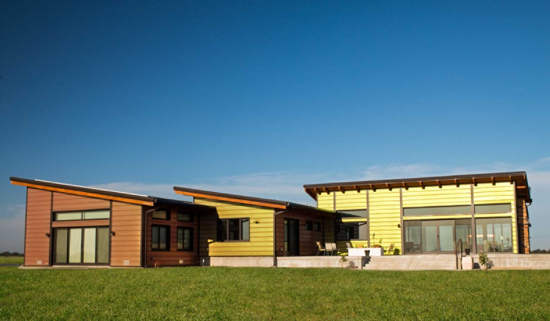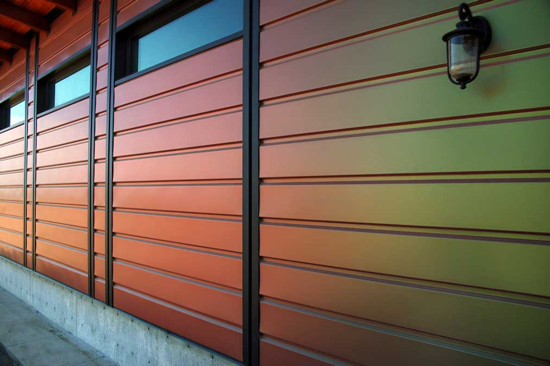Solar Reflective Coatings - A Cooler Way To Build
By: Jeff Alexander, VP of Sales, coil and extrusion division, Valspar Corporation
 |
Jeff Alexander |
Anytime you look at a new building, whether it’s an impressive skyscraper or a quaint residential home, the architectural scheme and exterior aesthetic is often the feature that first captivates our attention. Although the exterior beauty is important, the functional qualities of materials used to build a structure are just as vital to both its short-term and long-term success, especially when it comes to sustainability and reducing energy consumption.
According to the U.S. Green Building Council, buildings consume 73 percent of U.S. electricity and are responsible for 38 percent of U.S. CO2 emissions. Energy costs and concerns about global warming are challenging manufacturers to work harder than ever to develop high-performance products that lessen the negative impact on the environment. For coatings, one of the most impactful advancements that addresses these issues is the development of solar reflective coatings.
Essentially, solar reflective coatings reflect the sun’s harmful rays away from a building’s surface. This may sound simple, but the advanced coating formula dramatically combats one of the largest energy problems facing the modern world.

| |
For the new Polk Penguin Conservation Center at the Detroit Zoo, Valspar’s Fluropon Classic II Special SR provides the right look, the desired durability and last but not least, energy efficiency. The coating contains 70 percent PVDF resins, resulting in outstanding protection against dirt and staining as well exceptional color consistency and retention. The custom Iceberg White coating also features Valspar’s solar reflective technology, which offers high resistance to harmful UV rays. The solar reflective coating will help reduce overall energy consumption and keep the interior of the penguin center cool, maintaining an environment as natural as the penguins’ original Antarctic habitat. | | |
As the fierce rays of the sun reach the surface of a building’s roof and exterior, the absorbed infrared light is converted to heat, which steadily increases interior temperatures. This problem is further compounded throughout dense urban developments by smog, asphalt and lack of vegetation, which generates a phenomenon known as the “heat island effect.” If unchecked, this issue can radically increase air conditioning use and overall electricity expenses throughout a city, further escalating the global energy crisis.
In an effort to help diminish the heat island effect and provide architects with a wider range of sustainable building materials, coating manufacturers developed formulations that reflect infrared radiation while still absorbing the same amount of visible light. The result was solar-reflective pigments that have been incorporated into exterior metal panel coatings. Roofs and siding that utilize these coatings stay much cooler than their non-reflective counterparts. Not only do these coatings help lower energy costs without sacrificing durability, performance or appearance, they also provide an array of color options that previously absorbed considerably higher amounts of infrared light.
In the past, the most effective way to construct a cool roof was to use non-metal materials composed of light colors (usually white tones), which typically reflect larger amounts of sunlight than colored options. Although most architects and building owners understand the basic concept that light colors reflect heat better than dark, the reality is that adhering to this simple principle drastically restricts the creative design options.
Thanks to advancements in coating chemistry and the development of solar reflective pigments, these limitations are a thing of the past. Today, a far greater number of color options can be formulated as a solar reflective coating, allowing for superior innovative potential for architects looking to construct sustainability-focused buildings.
| |  |
| | Furthering their sustainable goals, Ilhan and Kamer Eser chose Valspar’s Fluropon SR coating in Surrey Beige for their home’s roof, adding solar reflectivity and increasing energy efficiency. Under the harsh California sun, the roof is expected to conserve up to 40 percent in energy expenditures by reducing its surface temperature by 50 to 60 degrees more than customary roofing materials. The Surrey Beige color of the roof also complements the home’s overall artistic design, pairing beautifully with the innovative color-shifting siding that was achieved through the use of Valspar’s Kameleon™ Colors. Not only does the solar reflective coating contribute to the home’s green-friendly goals, it also completes an inventive architectural aesthetic. | |
| |  |
Furthermore, metal paneling clad with a high-performance, solar reflective coating is now one of the leading construction practices that reduces the overall energy consumption of a building. Conventional materials used on roofs absorb up to 85-95 percent of solar heat energy1. Alternatively, cooler roof options, such as metal paneling sheathed in Valspar’s Fluropon® SR coating, combine to absorb less than 30 percent2. Because of its elevated reflectance and lower surface temperatures, this cool roof option can also decreases interior air temperatures, which lessen energy costs and help reduce the heat island effect. Valspar estimates that if implemented nationwide, cool roofs could lead to an average of $20 to $30 of savings per year, per 1,000 square-feet of roof space, yielding an annual savings of $1 billion3.
The effect of solar reflective coatings isn’t limited to urban settings and industrial buildings; they can also make a dramatic impact on the energy expenditures of residential homes as well. Recently in California, one couple selected coated metal panels as the defining feature for both the exterior and roof of their new residence.
Ilhan and Kamer Eser were looking to downsize after the last of their three daughters left the family home. After all of their years living in different homes and different states, the Esers decided the time was finally right to build their own home in the California countryside.
As the CEO of MORIN, a Kingspan Group Company, Ilhan also recognized that his home construction gave him an interesting opportunity to utilize his company’s metal panels in an unconventional way. Utilizing Kingspan Insulated Panels for the walls and roof would not only give the home a modern appearance, but also provide an R-value of 42—well exceeding California’s building standards.
Furthering their sustainable goals, the couple chose Valspar’s Fluropon SR coating in Surrey Beige for the home’s roof, adding solar reflectivity and increasing the home’s energy efficiency. Under the harsh California sun, the Esers expect the roof to conserve up to 40 percent in energy expenditures by reducing its surface temperature by 50 to 60 degrees more than customary roofing materials. The Surrey Beige color of the roof also complements the home’s overall artistic design, pairing beautifully with the innovative color-shifting siding that was achieved through the use of Valspar’s Kameleon™ Colors. Not only does the solar reflective coating contribute to the home’s green-friendly goals, it also completes an inventive architectural aesthetic.
1 Data sourced from Cool Roofing Solutions: http://tsproofsystems.com/cool-roofing-solutions/
2 Data sourced from Valspar: http://www.valsparcoilextrusion.com/opencms/export/sites/coilextrusion/galleries/pdfs/resources/Fluropon_val110_012813.pdf
3 Data sourced from Valspar Green Focus Brochure: http://www.valsparcoilextrusion.com/opencms/export/sites/coilextrusion/galleries/pdfs/Valspar-GreenFocus-Brochure.pdf
About Sherwin-Williams Coil Coatings
 Sherwin-Williams Coil Coatings delivers a full range of high-performance coil and extrusion metal coatings, designed to meet the most demanding environmental requirements while providing protection against weathering and pollution. The Coil Coatings Division
is part of the Sherwin-Williams Performance Coatings Group, which supplies a broad range of highly-engineered solutions for construction, industrial, packaging and transportation markets in more than 110 countries in the world. Founded in 1866, The
Sherwin-Williams Company is a global leader in the manufacture, development, distribution and sale of paints, coatings and related products to professional, industrial, commercial and retail customers. For more information about Sherwin-Williams
Coil Coatings, visit coil.sherwin.com.
Sherwin-Williams Coil Coatings delivers a full range of high-performance coil and extrusion metal coatings, designed to meet the most demanding environmental requirements while providing protection against weathering and pollution. The Coil Coatings Division
is part of the Sherwin-Williams Performance Coatings Group, which supplies a broad range of highly-engineered solutions for construction, industrial, packaging and transportation markets in more than 110 countries in the world. Founded in 1866, The
Sherwin-Williams Company is a global leader in the manufacture, development, distribution and sale of paints, coatings and related products to professional, industrial, commercial and retail customers. For more information about Sherwin-Williams
Coil Coatings, visit coil.sherwin.com.




